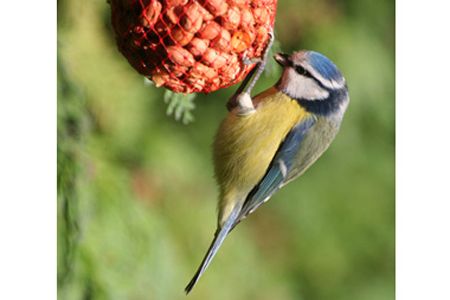Male Birds Like Nice Nests

(ISNS) -- One bird species may have advice on how to get its dads to take a more active role in parenting: mothers should build a snazzy crib.
Female blue tits that construct bigger nests and decorate them with fragrant plants have male partners that are more willing to invest in raising chicks, Spanish researchers report in the journal Behavioral Ecology.
A big, well-decorated home may send a signal to males about the health of their partners, said Gustavo Tomás of the Estación Experimental de Zonas Áridas in Madrid, and co-author on the study.
Females in many animal species are often believed to be the picky sex when it comes to choosing a mate. That’s because females usually devote more time and energy than males to raising their offspring.
A female blue tit – which is about the size of an adult hand, from beak to tail – picks her partner based on his colorful blue and yellow plumage and the sweetness of his song. The better looking and sounding a mate, the better the chances he won’t be teeming with parasites and that the couple will have healthy chicks.
But the research team found that males might also judge their mates.
“It was traditionally thought that only males need to show of their quality,” said Tomás. “Now we’re revealing it’s not that simple. It’s an interaction between sexes.“
Sign up for the Live Science daily newsletter now
Get the world’s most fascinating discoveries delivered straight to your inbox.
Different bird species divide the work of building nests in different ways. Female blue tits work alone to build nests, although males may add feathers later on. That means the nest may provide a window to the female's health.
After spring mating, female blue tits collect moss and grass to construct the base of their nests inside the hollows of trees or artificial nesting boxes. Females then line those nests with soft hair, wool, or feathers. Fit females can also search for hard-to-find plants – like mint, lavender, and rosemary – to spruce up the homes for their future nestlings. But all of this construction takes energy and puts a female in danger of attack from predators.
"The female can't cheat, it's an honest signal of what the female's ability is," said Bob Montgomerie, biologist at Queen's University, in Kingston, Ontario, who was not involved in the research. A haggard female would probably produce a pretty pitiful nest, said Montgomerie.
After the female finishes the nest, both sexes feed and defend the young. "The effort devoted by males is very important in the success of the females and in how many chicks will survive," said Tomás.
Tomás and his colleagues at Madrid's Museo Nacional de Ciencias Naturales made some nests smaller and added grass and moss to others to make some larger. The team also added or removed odorous plants from different nests.
The researchers found that these features influence the care a male will put into the nestlings and how many babies survive.
“This is the first [study] I know of that looks at nest traits themselves and how the male responds,” said Montgomerie.
At larger nests and those with strongly scented plants, males were more likely to be bolder and take more risks in caring for their young -- such as entering nesting boxes when there was danger -- than males at smaller nests or those lacking the plants, the study reported.
As part of the study the team installed bird traps in blue tit nesting boxes, a process that sometimes scared the birds away from home or made them more skittish. The males who put themselves out on a limb were more likely to be trapped, but also had a greater fraction of their offspring survive, said Tomás.
The team is not certain how this difference in risk-taking actually helps the nestlings. Tomás believes, in part, that males who take more risks may be more willing to defend a nest against predators.
The researchers combined their observations of eight different risk-taking behaviors into one measurement of a male’s boldness. For example, they tallied whether a male entered the nest first, waited for the female to enter as signal that the coast was clear, or didn’t enter the nest at all. Tomás and his colleagues used the risk-taking figure to estimate how much the males imperiled themselves in caring for their young.
“Taking the average of a bunch of subjective measures is never a good way to estimate something,“ said Montgomerie, who hopes that the team will follow up with a more detailed look at each risk-taking behavior. But “there’s an interesting pattern there and it opens up lots of possibilities [for future work],” he adds.
Tomás is interested in exploring more features of nests built by female birds and the signals they may send to males. “People thought that its only function was to form a receptacle for the eggs,” he said. But he believes the nests may reveal a lot of information about the bird that built it.
Ryder Diaz is a science writer based in Santa Cruz, Calif.
Inside Science News Service is supported by the American Institute of Physics.













